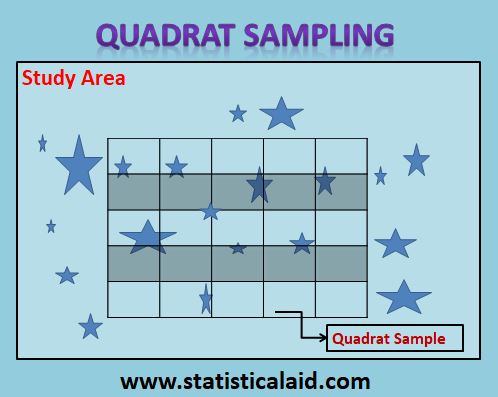Quadrat sampling is a classic tool for the study of ecology, especially biodiversity. It is an important method by which organisms in a certain proportion (sample) of the habitat are counted directly. It is used to estimate population abundance (number), density, frequency and distributions. The quadrat method has been widely used in plant studies. A quadrat is a four-sided figure which delimits the boundaries of a sample plot. The term quadrat is used more widely to include circular plots and other shapes.
Quadrat sampling methods are time-tested sampling techniques that are best suited for coastal areas where access to a habitat is relatively easy.
Assumptions of quadratic sampling
The quadrat sampling method has the following assumptions,
- The number of individuals in each quadrat is counted.
- The size of the quadrats is known.
- The quadrat samples are representative of the study area as a whole.
Advantages
Some advantages are given below-
- It sampling is easy to use, inexpensive.
- It is suitable for studying plants, slow-moving animals and faster-moving animals with a small range.
- It requires the researcher to perform the work in the field and, without care.
- It measures abundance and needed cheap equipment.
Disadvantages
Some disadvantages are given below-
Quadrat sampling is not useful for studying very fast-moving animals which are not stay within the quadrat boundaries.
- There exists biasness in favor of slow moving taxa.
- Collect only taxa that are present in the sampling time and not buried too deeper in sediment.
- It is a low estimate of taxonomic richness and assemblage composition.
- It is also a low detectability of among-site differences in assemblage composition.
- Some animals may experience harm if the scientist collects the population within the quadrat rather than studying it in the field.


This blog post on Quadrat Sampling provides a great overview of a technique that’s often overlooked in ecological studies. The examples you included really help clarify the practical applications. I appreciate how you explained the statistical rigor behind it—definitely a useful read for both beginners and seasoned researchers!
This post provides a clear and concise overview of Quadrat Sampling! I appreciate how you highlighted its applications and benefits in ecological research. The examples really help in understanding the methodology. Looking forward to more posts like this!
This post provides a great introduction to Quadrat Sampling! I appreciate the clear explanations and practical examples you included. It’s fascinating to see how this method can be applied in different ecological studies. Looking forward to more in-depth articles on sampling techniques!